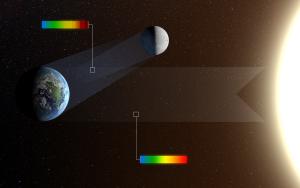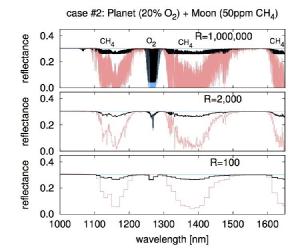Blog
Life Finds a Way
30 April 2014
 ESO/L. Calçada
ESO/L. CalçadaYesterday I mentioned how cutting edge research can sometimes lead to false positives. Sometimes what looks like a result turns out not to be. This is part of the reason we have peer review, and why we keep testing new results. Another way to eliminate false positives is to try to discover how your experiment could be fooled. If you are looking for a result, what else could produce a similar result? This is the goal of a new paper in the Proceedings of the National Academy of Sciences, which outlines how evidence of life on an exoplanet could be a false positive.1
 Rein, et al
Rein, et alOne of the ways we can search for evidence of life on exoplanets is to look at the spectrum of their atmosphere. Since different atoms and molecules absorb different wavelengths of light, we can in principle determine the make-up of an exoplanet’s atmosphere by looking at the light of the star as it passes through the atmosphere of the planet. We’ve actually been able to do this on a basic level, and with more powerful telescopes we should be able to obtain decent atmospheric spectra.
So how could we demonstrate the existence of life from a planet’s atmosphere? One way would be to look for different types of molecules in a state of chemical disequilibrium. In the paper the authors look at oxygen and methane. Methane and oxygen will tend to react to produce carbon dioxide and water. Since they react with each other, over time their quantities would diminish as they reach a chemical equilibrium. So if we discovered an exoplanet with the presence of oxygen and methane, that would be evidence of something driving the production of these molecules. On Earth, that driving mechanism is biologic in origin. Of course both of these gases can be produced by non-biologic processes as well, so just detecting one or the other wouldn’t be a strong indication of life.
As the authors demonstrate, if a planet with an oxygen atmosphere had a moon with an atmosphere containing methane, spectra from the two of them could overlap to produce an overall spectra that looks like a signature for life. The unfortunate result is that using technology in the near future a planet-moon combination would be indistinguishable from a bio-signature. So if we find an Earth-like world with such a signal we could never be sure whether the result is valid or a false positive. This kind of planet-moon combination would be rather rare, so if we found lots of bio-signatures we could be pretty confident that at least some of them are real implications of life.
But if we only find one, we won’t know if it is a false positive, or if life has found a way.
Rein, Hanno, Yuka Fujii, and David S. Spiegel. “Some inconvenient truths about biosignatures involving two chemical species on Earth-like exoplanets.” Proceedings of the National Academy of Sciences 111.19 (2014): 6871-6875. ↩︎